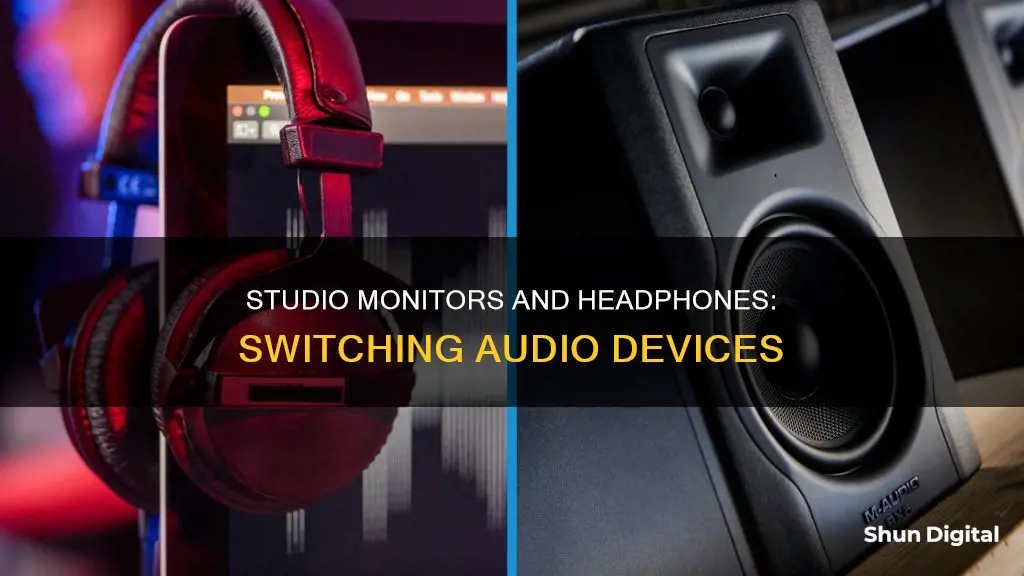
Switching between studio monitors and headphones can be a tedious task for music producers and audio engineers. While some prefer to simply turn the speakers down and put on headphones, others require more sophisticated setups. This is where monitor management systems come in, offering the ability to effortlessly switch between different monitor speakers and headphone mixes, saving time and enhancing workflow. These systems can range from simple monitor-switching units to more complex setups that allow for monitoring playback routing and subgroup cycling. Additionally, both digital and analog systems are available, catering to those who mix inside the box or prefer analog control. For those on a budget, a simple solution is to use a mixer with monitor and headphone outputs, allowing for easy switching by playing with a knob or two.
| Characteristics | Values |
|---|---|
| Difficulty switching between monitor speakers and headphones | It can be difficult to switch between monitor speakers and headphones, as some monitors do not have a button to easily facilitate this. |
| Solutions | Use a monitor with a headphone jack in an easily accessible place, use Bluetooth headphones, use a monitor switcher, or use a monitor with separate volume controls for headphones and speakers. |
| Monitor switchers | Save mixes and streamline your studio by allowing you to cycle through different speaker combinations effortlessly. |
What You'll Learn

Using a monitor switcher
Benefits of a Monitor Switcher
Monitor switchers offer a simple and convenient way to switch between different monitor speakers and headphones without constantly plugging and unplugging devices. With a dedicated knob or button, you can instantly route your audio output to your desired listening device. This saves you time and hassle, especially if you need to switch back and forth frequently.
Choosing a Monitor Switcher
When choosing a monitor switcher, you can opt for a simple passive monitor switcher or a more advanced monitor management unit. A basic switcher, like the Hosa SLW-333, allows you to switch between powered speakers with TRS connectors. On the other hand, a monitor management unit provides more flexibility and features, such as multiple input and output sources, headphone outputs, and even talkback systems. These units can be digital or analog, catering to your specific needs and preferences.
Setting Up the Monitor Switcher
Once you've selected your monitor switcher, setting it up is straightforward. Place the switcher between your audio interface and your monitors. Connect the audio interface output to the input of the monitor switcher, and then connect your studio monitors and headphones to the available outputs on the switcher. Make sure all connections are secure to ensure optimal audio quality.
Using the Monitor Switcher
With your monitor switcher set up, you can now easily switch between your studio monitors and headphones. Simply use the knob or button on the switcher to select your desired output device. This action will instantly route the audio output to your chosen device, allowing you to focus on your mix without any interruptions.
By using a monitor switcher, you can streamline your studio workflow, save time, and maintain a seamless listening experience. Whether you opt for a basic switcher or a more advanced management unit, the convenience of easily switching between devices will undoubtedly enhance your audio production process.
Monitor Lizard in Your Home? Here's How to Get Rid of Them
You may want to see also

Using a headphone amp/mixer
Using a headphone amplifier/mixer is a great way to easily switch between studio monitors and headphones. There are several devices on the market that can help you achieve this.
One option is to use a mixer, such as the Mackie 802-vlz3 mixer, which allows you to send the mains into an L/R stereo channel. You can then connect your monitors to the CTRL Room Outputs and your headphones to the headphone output. This setup provides the flexibility to plug in any other instruments or microphones, which will come through your headphones/monitors.
Another option is to use a standalone solid-state headphone amplifier. You can send the headphone output from your interface into the amp and then use monitors from your mixer and headphones from your amp. This setup allows for easy control of the levels of both output devices.
There are also devices specifically built for this purpose, such as the Samson S-Phone and the Coleman SPK5+1. These devices are great if you don't need a mixer but want a simple solution for switching between monitors and headphones.
Additionally, some audio interfaces, like the Audient ID4, have a Mute button that mutes the main speakers, allowing you to listen through headphones only. This can be a convenient feature if you don't want to purchase additional equipment.
When choosing a setup, it's important to consider your specific needs and preferences. If you require a more high-fidelity setup or want to plug in additional instruments or microphones, a mixer might be the best option. On the other hand, if you're looking for a simple and affordable solution, a dedicated monitor switcher or an audio interface with a Mute button might be more suitable.
Monitoring Watt Usage: Outlet Power Tracking
You may want to see also

Using a monitor controller
A monitor controller is a device that allows you to switch between different audio sources and select different outputs, such as studio monitors or headphones. It is a convenient way to manage your audio devices and easily switch between them without having to unplug and plug connections.
Monitor controllers typically have multiple input and output options, allowing you to connect your audio interface, studio monitors, and headphones. They often feature knobs or buttons to adjust the volume and select the desired input and output. Some monitor controllers also offer additional features such as talkback functionality, multiple headphone outputs, and remote control.
- Mackie Big Knob Studio Monitor Controller: This monitor controller offers a simple and intuitive way to switch between different inputs and outputs. It features a large volume knob, dim, mono, and mute buttons, and allows you to connect two pairs of monitors and switch between them easily.
- PreSonus Monitor Station V2 Desktop Monitor Controller: The PreSonus Monitor Station provides input and output routing capabilities, with four headphone outputs, source selection, and a talkback microphone. It also includes a remote control for added convenience.
- Behringer Studio XL Monitor Controller: This monitor controller offers Midas mic preamps and a USB audio interface. It provides easy switching between different inputs and outputs, along with volume control and mute functions.
- Audient Nero Desktop Monitor Controller: The Audient Nero offers comprehensive connectivity with two stereo line-level inputs, a cue mix input, two aux inputs, and three stereo speaker outputs. It also includes a talkback feature, headphone outputs, and controls for dim, cut, mono, and polarity.
When choosing a monitor controller, consider your specific needs and budget. Some monitor controllers offer basic functionality, while others provide more advanced features. Additionally, ensure that the monitor controller is compatible with your audio interface and other equipment.
By using a monitor controller, you can streamline your studio setup, making it easier to switch between studio monitors and headphones without the need for constant plugging and unplugging.
Temperature Device Calibration: How Often for Accuracy?
You may want to see also

Using a monitor control app
Monitor control apps can be used to switch between studio monitors and headphones without the need for constant plugging and unplugging. These apps provide separate volume controls for both devices, allowing users to easily switch between them.
For example, the Focusrite mix control app may allow users to mute the output to their monitors, while keeping their headphones active. This can be useful if your interface only has one physical control for the output level, controlling both monitors and headphones.
Additionally, some apps, like the PreSonus Monitor Station, offer features such as input and output routing, multiple headphone outputs with individual volume levels, and source selection. This can be especially useful for those who want more flexibility and control over their audio setup.
Another option is to use a digital audio workstation (DAW) to manage your monitor and headphone outputs. This can be done by routing all your monitor sends, talkback systems, headphone mixes, and mains through a compact desktop unit within your DAW. This allows you to cycle through different subgroups and monitor feeds with ease.
It is worth noting that some monitor control apps may only be compatible with specific interfaces or operating systems, so it is important to check the requirements before downloading. Additionally, some apps may require the use of specific hardware, such as a monitor with an output audio jack, to function properly.
Overall, using a monitor control app can streamline your workflow and provide more flexibility in managing your audio outputs.
Monitoring and Interpreting Vital Signs: A Basic Guide
You may want to see also

Using a monitor management system
A monitor management system can be a great way to streamline your studio setup and make switching between studio monitors and headphones a breeze. Here are some benefits and features of using a monitor management system:
Easy Switching Between Devices
Monitor management systems typically feature multiple outputs, allowing you to easily toggle between different sets of monitors, headphones, or even a subwoofer with the turn of a knob. This is especially useful if you want to compare how your audio translates across different types of speakers or if you need to switch between devices frequently.
Independent Control
These systems give you independent control over the volume levels of each device, so you can fine-tune the output to your liking. This is a significant improvement over standard interfaces, which often have a single control for both monitor and headphone levels.
Compact and Convenient
Monitor management systems are designed to be compact and fit easily into your desktop setup. They eliminate the need to crawl behind your desk to manually reconfigure output connections every time you want to switch devices.
Talkback Mic and Slate Output
Some monitor controllers include a built-in talkback microphone, which is useful for communicating with artists in the live room. Additionally, some units feature a "slate" output fed by the talkback mic, which can be used as a talkback monitor in the live room or even routed directly into your DAW for scratch vocals.
Multiple Inputs and Preamps
Monitor controllers often feature additional inputs, allowing you to connect and monitor external playback devices such as CD players, tape machines, or even your phone. Some units also include additional preamps that can be used for recording, providing more flexibility in your setup.
Analog and Digital Options
Whether you work with analog or digital systems, there are monitor management solutions available to suit your needs. You can choose from fully analog switching and routing units or digitally controlled analog systems that integrate seamlessly with your DAW.
Examples of Monitor Management Systems
- Mackie Big Knob Studio+
- Presonus Monitor Station V2
- Dangerous Music Monitor ST
- Crane Song Avocet IIA
- Dangerous Music D-Box+
- Grace Design m905
- Antelope Audio Satori
In conclusion, a monitor management system can greatly improve your workflow and give you more time to focus on creating. With their various features and options, these systems provide a convenient and flexible solution for anyone looking to streamline their studio setup.
Fixing Monitor Resolution Issues in Pillars of Eternity
You may want to see also
Frequently asked questions
You can use a monitor switcher or a monitor management system to switch between different monitor speakers and headphones without having to switch manually.
Some examples of monitor switchers include the Hosa SLW-333 Passive Stereo Monitor Switcher and the Mackie Big Knob Passive 2x2 Studio Monitor Controller.
Some examples of monitor management systems include the Trinnov NOVA Dante Audio Interface/Monitoring Processor and the PreSonus Monitor Station V2 Desktop Monitor Controller.







